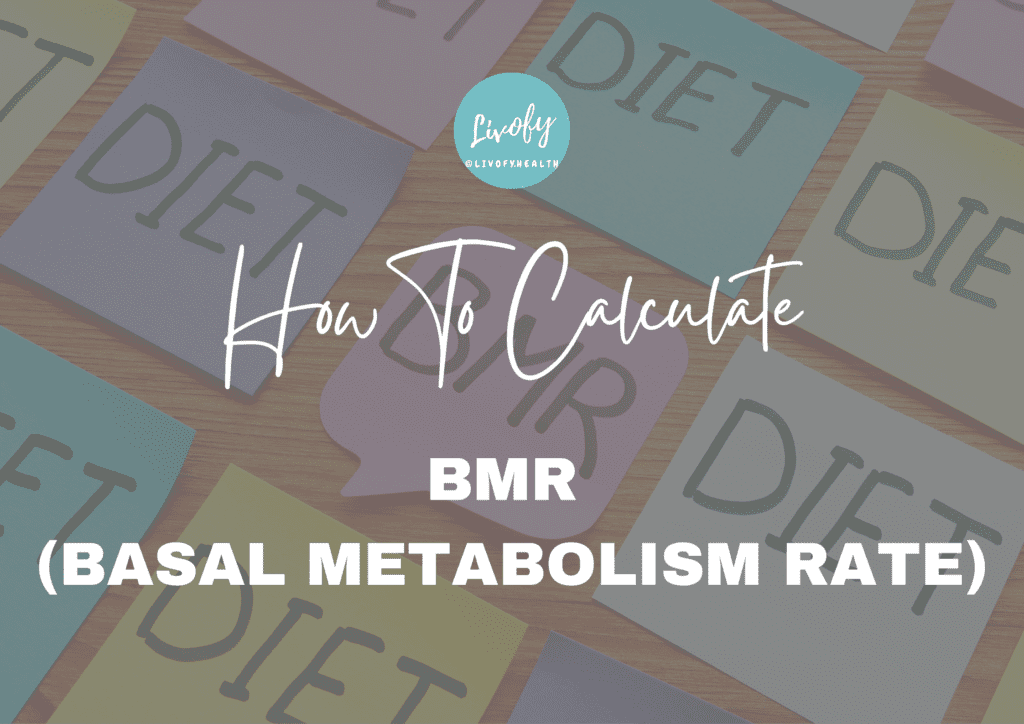Wondering what is BMR? Basal metabolism rate (BMR) estimates how much energy you use at rest in a neutrally temperate environment and in a post-absorptive condition (meaning that the digestive system is inactive, which requires about 12 hours of fasting). Keep on reading to know What is BMR and how to calculate BMR.
What is BMR -Basal Metabolism Rate?
Looking for BMR definition (What is BMR)? Your body burns calories at a basal metabolism rate (BMR), which measures how well your body is able to sustain life. Also known as Resting Metabolic Rate (RMR), this phrase refers to the number of calories you would burn if you spent the entire day in bed. In either case, many people determine their body’s metabolism using the basal metabolic rate formula.
Your basal metabolic rate (BMR) is what determines how many calories you utilize (or “burn” or “expend”) on an average day. This comprises the energy your body expends to keep your living, breathing body functioning normally, such as:
- The rhythm of our heartbeat
- Cell generation
- Respiration
- Keeping one’s body temperature constant.
- Circulation
- Processing of nutrients
Your individual metabolism rate, or BMR, is affected by a variety of variables, such as your age, weight, height, gender, environmental temperature, eating patterns, and exercise and exercise frequency.
What is BMR Basal Metabolism Rate used for?
The amount of energy required while at rest in a temperate environment and while the digestive system is not functioning is known as the basal metabolic rate (BMR). It is comparable to calculating how much gas a parked car uses when it is idle. Energy will only be utilized in this condition to sustain the body’s critical organs, which include the nervous system, intestines, liver, lungs, sex organs, muscles, and skin. For most people, daily maintenance accounts for up to 70% of total energy (calories) burned. 20% of expenditure comes from physical activity, and 10% comes from thermogenesis, the process of breaking down food.
The BMR is assessed when awake but under very limited conditions. In order to evaluate BMR accurately, a person must be entirely rested and have their sympathetic nervous system at rest. Usually, the largest portion of a person’s total caloric needs is their basal metabolism. Depending on activity level, the daily calorie requirement is equal to the BMR value multiplied by a factor with a value between 1.2 and 1.9 as per the BMR formula.
How to Calculate BMR (Basal Metabolism Rate)?
The Harris Benedict Equation, which takes into account weight, height, age, and gender is one common method of estimating BMR.
BMR Formula
Women:
BMR = 655 + (9.6 × weight in kg) + (1.8 × height in cm) – (4.7 × age in years)
Men:
BMR = 66 + (13.7 × weight in kg) + (5 × height in cm) – (6.8 × age in years)
How to calculate BMR by the Katch-McArdle Formula:
where:
H is body height in cm
A is age
F is body fat in percentage
What is an example of a BMR score?
The following BMR formula would be used for a 42-year-old male who is 5 feet 8 inches (173 centimeters) tall and weighs 200 pounds (91 kilograms): (88.4 + 13.4 x 91) + (4.8 x 173) – (5.68 x 42) = 1900 calories burned each day only to keep the body alive as per the harris benedict equation.
Basal Metabolism Rate vs. Resting Metabolic Rate
The BMR definition placed along with RMR makes much clear sense while looking for differences between the both. Resting metabolic rate (RMR) and basal metabolic rate (BMR) are frequently used interchangeably (RMR). RMR, also known as resting energy expenditure (REE), is the number of calories your body burns while at rest, as opposed to BMR, which is the minimal number of calories needed for fundamental processes while at rest. Although BMR and RMR have a small discrepancy, your RMR ought to be a reliable indicator of your BMR. Having said that, just because you have you burn calories doesn’t mean you have to miss out on Weight loss Delicious Recipes.
What is RMR?
Your body requires the amount of energy known as your resting metabolic rate to function while at rest. RMR takes into account additional low-effort daily tasks in addition to fundamental bodily processes. These actions consist of:
- Eating
- Walking during brief intervals
- Going to the restroom
- Drinking coffee
- Shivering or perspiring
How Do You Measure RMR?
The same formulae you would use to determine your BMR can also be used to estimate RMR. The same calorimeter can be used to administer a lab test.
You won’t need to spend the night there before the lab test, and you won’t need to limit your diet or exercise beforehand. Most likely, you’ll sit stationary in a well-lit environment as you complete the test.
Similarities Between RMR and BMR
The number of calories your body burns while you aren’t exercising is reflected in both your BMR and RMR. Typically, each person has around the same number.
What Sets BMR and RMR Apart
The best technique to gauge your metabolism at total rest is to use your BMR. Typically, it is a little less than your RMR. Your RMR is a more accurate estimate of your daily calorie requirements. It reflects your daily caloric expenditure more precisely.
Why is BMR important?
1. The main tool for diagnosing and treating thyroid diseases is the BMR formula.
2. Moderate hypothyroidism is indicated if BMR is less than 10% of normal. The BMR may be reduced to 40 to 50 percent below normal in cases of severe hypothyroidism.
3. Calculation for BMR helps determine how many calories or servings of food are needed to maintain a given body weight.
4. The BMR is low in Addison’s illness, lipoid nephrosis, hypothalamic abnormalities, undernutrition, and famine.
5. In cases of fever, diabetes insipidus, leukemia, and polycythemia, the calculation for BMR is higher than average.
Check out this BMR calculator to lose weight, and assess your health.
What is a good BMR for men and women?
A “good BMR” or Ideal BMR Chart does not exist. The calculation for BMR varies for each individual. Age, gender, body size, height, weight, mass, and even the size of your internal organs all play a role in it.
With a low BMR, you require fewer calories to maintain vital processes like breathing. In order to lose weight, you must consume fewer calories than someone with a higher BMR. Your BMR may increase as a result of illnesses, physical activity, medications, nicotine use, stress, and anxiety, among other factors.
Men often require more calories than women do, and their BMR is typically greater. This is due to the fact that men are often bigger and more muscular than women. Men’s BMR typically ranges from 1600 to 1800. This indicates that men burn between 1600 and 1800 kcal per day while at total rest. However, keep in mind that BMR is based on your personal height, weight, and age; therefore, it is not recommended to use typical figures.
The average BMR for women is 1550 calories per day.
Once more, the calculation for BMR will vary based on the particular woman and her physical attributes.
Factors that affect our BMR
The BMR formula is impacted by numerous things. The circulating levels of hormones such as catecholamines (epinephrine and norepinephrine) and those released by the thyroid gland are among these, as are body temperature, age, sex, race, emotion, and climate.
Genetics
Some individuals are born with a faster metabolism than others. Chinese and Indians appear to have lower BMRs than Europeans do. The dietary variations between various races could also be the cause of this. Individuals that live in tropical climates have higher BMR. Ex. Singapore.
Gender
Men have a lower body fat percentage and more muscle mass. So, compared to women, men have a higher baseline metabolic rate. Between the ages of 5 and 17, the BMR of girls drops more quickly than that of boys.
Age
Age-related BMR declines; that is, it is inversely proportional to age. Compared to adults, children have higher BMR. It decreases by roughly 2% per decade after 20 years.
Weight
The BMR increases with body weight; for example, obese women’s metabolic rates are 25% higher than those of slim women.
Body Surface Area
This reflects the person’s height and weight. The BMR increases as the body surface area increases. BMRs are greater in tall, skinny people. If two people of equal weight, one tall and one short, adopt calorie-restricted diets to maintain the taller person’s weight, the shorter person may gain up to 15 pounds in a year.
Body Fat Percentage
The BMR increases as body fat percentage decreases. One of the reasons why males often have a BMR that is 10-15% greater than women’s is the lower body fat content in the male body. As per research, Keto Diet Plans can help improve the Body Fat Percentage significantly.
Diet
A major calorie restriction or starvation can significantly lower BMR by as much as 30%. BMR may decrease by up to 20% when following calorie-restrictive weight loss programs. BMR is 11% lower among committed vegetarians compared to meat eaters.
Body Temperature
The Basal Metabolism Rate rises by around 7% for every 0.5° C increase in body temperature. At greater temperatures, the body’s chemical processes really move more swiftly. Therefore, a patient with a 42° C fever (about 4° C above normal) would have an increase in BMR of nearly 50%. The BMR rises by 14–15% per degree Celsius when a person develops a fever, which is clearly caused by the body’s increased rate of metabolic processes.
External Temperature
The ambient temperature has an impact on basal metabolic rate as well. The BMR rises when exposed to cold temperatures, producing the extra heat required to keep the body’s internal temperature constant. Due to increased heat loss, a brief exposure to high temperatures has little impact on the body’s metabolism. However, continuous heat exposure might increase BMR.
Glands
A crucial BMR regulator that increases the body’s metabolic activity is thyroxine. The Basal Metabolism Rate increases as thyroxine production increases. BMR can actually double if too much thyroxine is produced (thyrotoxicosis). BMR may decrease to 30–40% of the usual rate if too little thyroxine is generated (myxoedema). Adrenaline also raises BMR, albeit to a smaller level than thyroxine. Even when the patient appears to be calm, anxiety and tension nonetheless cause an increased tensing of the muscles and the release of norepinephrine. The metabolic rate is tended to increase by both of these causes.
Exercise
Exercise affects body weight by burning calories, but it also helps increase BMR by adding more lean muscle. (Fat tissue requires less energy from the metabolism than lean tissue.) So even as you sleep, you burn more calories.
Pregnancy
Throughout pregnancy, the BMR remains constant. The fetus’s BMR accounts for the late-pregnancy BMR’s greater value.
How you can change your BMR?
Whether or not you can change your BMR is a frequent query. Genetics has a role in determining your BMR, but there are ways for your body to naturally alter it. You can additionally look at Expert Diet Treatment for doing it the right way.
Losing Weight
Your physique will change if you lose weight. This is a component of a process known as metabolic adaptation, which means that your metabolism adapts to physical changes in your body. It’s incredible what our bodies are capable of, isn’t it? Then, what does this indicate for your BMR—basal metabolic rate? Your BMR will drop if you lose weight. Your physique will get smaller as you lose more weight. You won’t be able to burn the same amount of calories passively if your body is smaller than usual. You can use a BMR calculator to lose weight.
Moving More
Go on moving. Activity is the best strategy to enhance your overall calorie burn. The solution, then, is to move more. either try to improve your NEAT activity or try to boost your daily step objectives. Non-exercise activity thermogenesis is referred to as NEAT. This can include cleaning up after yourself, going to bed, or sleeping. Over the course of the day, these kinds of actions build-up. Consider a scenario in which you are shedding pounds but don’t want your BMR to decrease. What other options exist? The truth is that when you lose weight, both exercising and doing nothing will result in you burning fewer calories. You can move more each day, but it won’t make much of a difference. A ripple effect results from losing weight. Looking for motivation? Check out a few Weight loss blogs here and keep it revving up!
How to use BMR to lose weight?
Your BMR is a helpful tool for figuring out how many calories to remove from your diet each day to lose weight safely.
Knowing how to calculate BMR and the correct calculation for BMR will assist you to avoid restricting too many calories, which will make you drained, agitated, and hungry. The BMR is not a diet technique in and of itself. This is why so many diets fail since it’s not the ideal method to start a long-term weight loss journey.
- Determine your BMR which will provide you with the recommended daily minimum of calories.
- The appropriate daily calorie intake for you can then be calculated by deducting the number of calories you need to maintain your weight from the number of calories you need each day.
As a general rule, the average man needs around 2,500 calories each day, while the average lady only needs 2,000 calories.
To get the most accurate results, however, you should calculate your calories according to your unique needs because we are all unique.
Your degree of physical exercise is another thing to consider. You won’t need to reduce your calorie intake as much to lose weight as someone who leads a more sedentary lifestyle if you have an active job or routinely exercise.
Using a BMR calculator or a BMR chart, where you can enter your vital statistics and degree of exercise, is the best approach to receiving an exact answer.
Then, you can subtract some calories, creating a deficit, while still staying above your BMR calories.
For weight loss, a general rule of thumb is to create a daily deficit of no more than 500 – 600 calories. This will ensure steady and sustainable weight loss. Aim to lose about 0.5 to 1kg (1 to 2lb) a week until you reach a healthy weight for your height.
Remember, most people need over 1000 calories each day just to maintain their basic, life-sustaining functions. This is why restrictive ‘crash’ diets are really bad news for your body. Not getting enough energy each day can interfere with your body’s basic processes, such as causing reduced brain function, low blood pressure, or abnormal heart rate.
So, you should always take in, as a minimum, the number of calories you need to maintain basic functions as indicated by your BMR. Lack of energy can affect your body’s fundamental functions, such as reducing brain function, lowering blood pressure, or generating an irregular heartbeat. Therefore, you should always consume at a minimum the number of calories recommended by your BMR in order to sustain your basic bodily processes. Research some good Weightloss Diet Plans to improve your BMR.
Understanding your BMR – How many calories do people need?
The next step is to add the number of calories you burn each day according to your lifestyle if you calculated your BMR using the Harris Benedict Equation:
Sedentary: Increase your BMR by 1.2 if you exercise very little or not at all.
Somewhat Active: Add 1.375 to your BMR if you engage in light activity one to three days per week.
Fairly Active: Add 1.55 to your BMR if you work out three to five days per week.
Pretty Active: Increase your BMR by 1.725 if you exercise hard six to seven days per week.
Highly Active: Increase your BMR by 1.9 if you work out really hard six to seven days a week or have a physically demanding profession.
The final figure is roughly how many calories you require each day to maintain your weight.
This is an estimate, of course. The calculation would be more accurate if it took into account body composition, weight history, and other variables that have been demonstrated to affect BMR.
Use this BMR Calculator to lose weight.
FAQs
How is BMR related to Weight gain?
You can figure this out using your BMR! (what is BMR) Suppose, for instance, that you desire to gain 1 pound each week and have a BMR of 1,500 calories. Considering that 3,500 calories make up one pound, you should normally consume an additional 3,500 calories daily, or 500 calories more.
Is BMR interpreted the same way for Children and Teens as it is for Adults?
Although BMI is used for both children and adults, it is not always interpreted in the same way. The same formula is used for both children and adults, but when measuring youngsters, age and gender are also taken into account in addition to height and weight.
How to Increase Daily Calorie Expenditure to maintain BMR?
Consuming more foods high in protein can prevent sluggish metabolism. This is due to the fact that eating, digesting, and absorbing protein-rich foods causes your body to burn more calories. The thermic impact of food is what’s responsible for this (TEF). Foods heavy in protein have a greater TEF than those high in carbohydrates and fat.
What is a Normal BMR?
The normal BMR percentage lies between – 15% and – 5%. Most hyperthyroid patients have a BMR of 20% or more in the positive range, while most hypothyroid patients have a BMR of 20% or less in the negative range.









